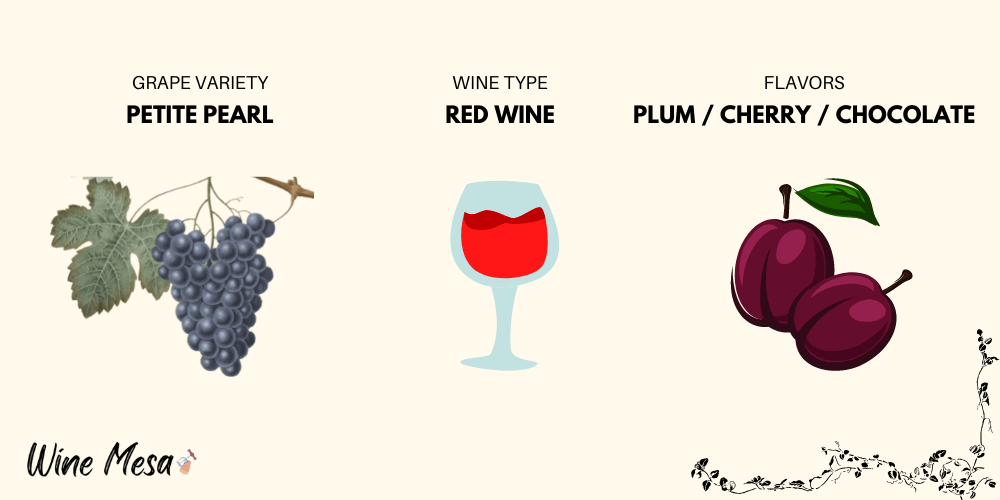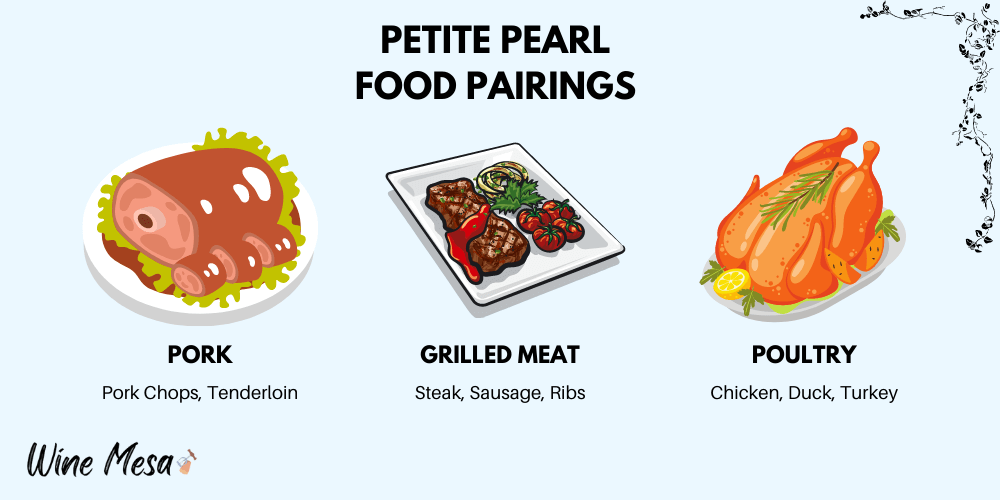Wine has been around for almost as long as humans have been building civilization, and a myriad of the wines on the market today all have recipes stretching back hundreds of years. However, there are plenty of wines that are more contemporary.
Petite Pearl Wine is one of the newer types of wine on the market, and it’s also a great wine for any beginner wine enthusiast
What Is Petite Pearl Wine and Where Does It Come From?
Petite Pearl Wine is a red wine known for its medium bodied flavor and the unique aromas that stand out a little more than the aromas of other wines.
Petite Pearl Wine is made with the Petite Pearl grape. The Petite Pearl Grapes comes from Minnesota and is a hybrid grape that was bred into existence by Tom Plocher in 1996.
Tom Plocher is well known and well respected in the wine community, The wine itself didn’t hit the market until 2010, so it’s more contemporary. wine.

What Does Petite Pearl Taste Like?
Petite Pearl Wine flavor varies from winery to winery. However, there are a few flavors that can be found in almost any brand; plum, cocoa, cherry, and black tea.
As previously mentioned, it’s a medium-bodied wine that tends to have 12.5% to 13.5% Alcohol by volume.
Best Petite Pearl Examples
All of the following wines should be served at room temperature because Petite Pearl is a dry, red wine. If you chill it, you’re risking overshadowing the flavor profile.
Parallel 44 Reserve Petite Pearl – This wine comes from the Parallel 44 winery in Wisconsin. Its flavor profile consists mostly of blackberry and plum, but it also has hints of Mocha. This wine is best served with grilled steaks, beef stew, or wild game.
St. Julian Braganini Reserve Petite Pearl – Similar to Parallel 44 reserve with the mocha after taste, but the initial taste is made up of blueberry and clove as opposed to plum and blackberry. This wine works with will steak, cheese, and almost every other type of red meat.
Shelburne Vineyard Petite Pearl – The flavor with this one is unique, with chocolate, nutmeg, and oak making up the majority of the flavor profile. Cherry and black cherry can sometimes be tasted depending on how sensitive your pallet might be. This wine works well with dark chocolate, steak, and hamburgers.
Maelström Petite Pearl – The Petite Pearl from the Maelstrom Winery is more of a classic petite pearl taste, so if you’ve read this far you’ll already have an idea of what it tastes like when you’re sipping it. Like the previous wine, this wine is best with dark chocolate, steak, and hamburgers.
Karlo Estates Property Grown Petite Pearl – The Karlo Estates winery has one of the highest-rated versions of the Petite Pearl Wine. With the flavor consisting of plum, blackberry, cranberry, and jam, the flavor profile is unique and delightful. It also has an earthy aroma with hints of tobacco smoke, balsamic, coffee, and cedarwood.
If you’re looking to try a new wine out, you can’t go wrong with this particular brand of Petite Pearl. Not only does it taste excellent, but it’s also a good training tool to teach new wine enthusiasts how to taste test and identify the different flavors of wine. This wine pairs well with almost everything that is meaty. It also pairs well with chocolate.
What Food Pairs Well with Petite Pearl?
There are various food combinations that go with the different types of Petite Pearl wine. But there is a general theme to what you should be pairing with this particular wine.

Steak – Steak is almost universally accepted as a good combination for dry wines, and Petite Pearl wine is no different. The flavors mix really well to give you a heightened flavor awareness of the Petite Pearl.
Hamburger – Usually one would think of beer when talking about hamburgers, but Petite Pearl’s unique flavor profile lends itself well to the meat, tomatoes, and cheese found on hamburgers.
Dark Chocolate – Dark chocolate goes well with most red wines, and it goes especially well with Petite Pearl Wine
Cheese – As touched on earlier, cheese goes well with Petite Pearl wine. The flavors just mix really well and will leave your taste buds happy.
Tomatoes – Tomatoes are a long-time staple in wine culture for how they tend to mix with the dry red wines. This is true for sauces too.
Is Petite Pearl Sweet or Dry?
Petite Pearl is a dry wine, and, as previously mentioned, it is best suited for pairing with food. Because of its dry nature, Petite Pearl is higher in ABV, and exactly how high it will depend on the winery you decide to get it from.
How Is Petite Pearl Made?
The method used is largely universal: you take Petite Pearl grapes, press them (straining the juice from them), mix them with a fermenting agent (yeast is the most popular), and then allow it to set in a fermenting barrel for a certain amount of time.
The time it takes for Petite Pearl in particular varies from winery to winery, but the average is somewhere between 3-7 years. The longer a wine ferments, the better it’s going to taste.
There are special tools known as airlocks that most winemakers use to determine whether or not the wine is done fermenting.
A common mistake that new wine-makers make when using an airlock is using the airlock to fully determine when the fermenting process is finished.
Sometimes the fermenting process stops because there was a change in temperature that the yeast did not like.
There’s a reason why professional wine-makers keep their aging barrels in cellars that have constant temperatures.
It’s to eliminate the challenge of having to deal with the yeast starting and stopping fermentation whenever it feels comfortable.
Another big factor in the aging process is the type of barrel used in the process. There are many different types of barrels that can be used, but the most common type is the oak barrel.
It’s been used to age wine for hundreds of years, and it will probably never go out of style. Another popular type of barrel to use is cedar barrels.
The reason the barrel is important is that it can either enhance the flavor or make the flavor taste off. If you use a concrete barrel (yes, those exist) you’re going to have a very boring, profile in your wine.
The one benefit to using concrete is that it oxygenates the wine better than typical wooden barrels.
